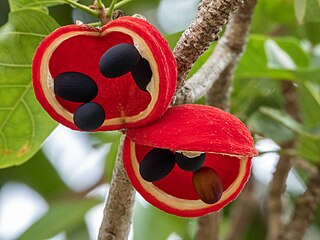
Sterculia quadrifida, also known as the peanut tree, monkey nut or red-fruited kurrajong is a small tree that grows in some forests of New Guinea and Australia.

Eupomatia laurina, commonly named bolwarra, native guava or copper laurel, is a species of plant in the primitive flowering-plant family Eupomatiaceae endemic to Australia and New Guinea.

Alpinia caerulea, commonly known as native ginger or Australian ginger, is an understorey perennial herb in the family Zingiberaceae which grows in rainforest, gallery forest and wet sclerophyll forest in eastern Australia.

Semecarpus australiensis, commonly known as the tar tree, native cashew, marking nut, or cedar plum, is a species of tree in the cashew and mango family Anacardiaceae, native to parts of Melanesia and northern Australia. Contact with the plant can cause serious allergic reactions, a common characteristic of this family.

Calamus australis, commonly known as wait-a-while, hairy mary or lawyer cane, is a plant in the palm family Arecaceae which is endemic to the rainforests of north east Queensland, Australia. Like other species in the genus Calamus, this is a climbing plant with a very long and flexible stem. It uses sharp strong hooks on the fronds and tendrils to attach itself to other vegetation, such as taller established trees, thus gaining support that enables it to grow higher towards the canopy. This species is very similar to C. radicalis, with which it coexists, but is smaller in almost all respects.

Celtis paniculata, commonly known as tripewood, silky keltis, silky celtis, native hackberry, native celtis, Investigator tree or whitewood, is a rainforest tree native to parts of Malesia, Melanesia and Australia.

Atractocarpus fitzalanii, commonly known as the brown gardenia or yellow mangosteen, is a species of plant in the coffee and madder family Rubiaceae. It is found in coastal parts of tropical Queensland, Australia. The beautifully scented flowers and glossy foliage has seen this plant enter cultivation in gardens of eastern Australia.
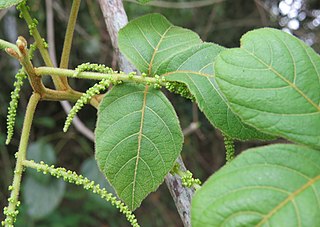
Allophylus cobbe, commonly known as titberry or Indian allophylus, is a pantropical, shrub in the family Sapindaceae with many uses in traditional medicine. It has a highly variable morphology throughout its range and may prove to be more than one species.

Didymocheton pettigrewianus, commonly known as spur mahogany, spurwood, or Cairns satinwood, is a large tree in the family Meliaceae. It is native to the rainforests of Malesia, Papuasia and Queensland. In Queensland it occurs only in a small part of the northeast coast.

Rhodomyrtus macrocarpa, commonly known as finger cherry, Cooktown loquat, or wannakai, is a species of plant in the family Myrtaceae native to New Guinea, the Aru Islands, and the Australian state of Queensland. Eating the fruits is reputed to cause blindness.

Blepharocarya involucrigera is a tree in the mango and cashew family Anacardiaceae. It is endemic to Queensland, Australia. Common names include north Queensland bollygum, northern bollygum and rose butternut.

Syzygium alliiligneum, commonly known as onionwood, Mission Beach satinash or bark in the wood is a species of plant in the family Myrtaceae. It is endemic to a small part of north eastern Queensland.

Licuala ramsayi, commonly known as the Queensland fan palm or Australian fan palm, is a species of tree in the palm family Arecaceae which is endemic to northeastern Queensland, Australia. Two varieties are recognised: Licuala ramsayi var. ramsayi, and Licuala ramsayi var. tuckeri. It is the only species of the genus Licuala present in Australia.

Syzygium forte, commonly known as flaky-barked satinash, white apple or brown satinash, is a tree in the family Myrtaceae native to New Guinea and northern Australia.

Myristica insipida, commonly known in Australia as Australian nutmeg, Queensland nutmeg or native nutmeg, is a small rainforest tree in the family Myristicaceae native to parts of Malesia, Papuasia and Australia. It is closely related to the commercially-important species of nutmeg, M. fragrans.
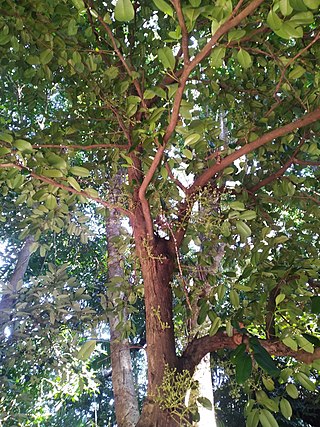
Syzygium branderhorstii, commonly known as the Lockerbie satinash, is a small tree in the family Myrtaceae found in New Guinea, the Bismarck Archipelago, Solomon Islands, Santa Cruz Islands, and northern Queensland, Australia. It is cauliflorous, producing large inflorescences from the trunk. The fruits are eaten by brush turkeys.

Hypserpa laurina is a slender twining climber in the plant family Menispermaceae. It is native to New Guinea and northeastern Queensland in Australia.
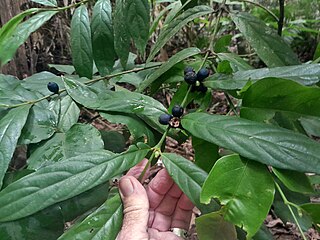
Lasianthus chlorocarpus, commonly known as blue rubi, is a plant in the family Rubiaceae native to parts of Malesia, Papuasia and Australia. It is an evergreen shrub growing up to 2 m high in well developed rainforest.

Sterculia shillinglawii, commonly known as tulip sterculia or lacewood, is a tree in the cotton and cocoa family Malvaceae, native to Papuasia and northeastern Australia.
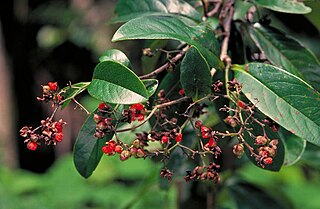
Tetracera daemeliana, commonly known as large-leaved fire vine, is a vine in the guinea flower family Dilleniaceae first described in 1886, which is endemic to the northern half of Queensland, Australia. The flowers are pleasantly perfumed.






















